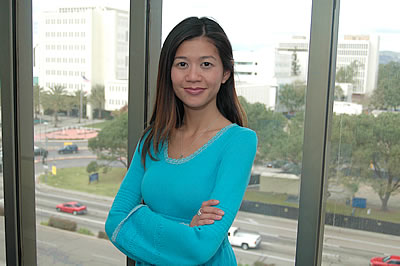April 20, 2006
by Valerie Orleans
On federal, state and local levels, elected officials increasingly find themselves trying to provide more services on ever-shrinking budgets. Frances Teves, director of state relations and advocacy, works closely with state officials sharing the CSUF story to garner support for the campus and its programs.
| Q: |
What is the primary function of advocacy as it relates to the university? |
| A: |
We have three different areas of focus. The first is the federal level, working with representatives of Congress and the White House. The second level, where I am most involved, is the state. I concentrate most of
my attention on state senators, assembly members and the governor. At the local level, we’re working with mayors, city council members, superintendents and other officials. |
|
| Q: |
What are your overarching goals? |
| A: |
We want to establish, cultivate and maintain relationships. Our ultimate
goal is to increase community and public support on the value and impact of higher education. |
|
| Q: |
Could you give a specific example? |
| A: |
Sure. For instance, Senate Bill 724 recently authorized the CSU to independently provide doctorates in education. Fullerton will be one of the first campuses in the CSU to offer this new degree. However, prior to SB 724’s passage, only UCs and private colleges could offer Ed.D. degrees in California. Previously under the Master Plan for Higher Education, CSUs were only allowed to offer bachelor and master’s degrees. [CSUF did offer an Ed.D. in conjunction with UCI as a joint doctorate.]
The need for those with an Ed.D. continues to grow. We, as a system, were able to present a compelling case to the state legislature describing how the CSUs would be able to meet this need and why we should be allowed to provide this type of degree program as well. |
|
| Q: |
But legislators have more to worry about than just higher education. |
| A: |
Yes, they do. But when legislators are looking at ways to meet the budget, we certainly don’t want them to forget us. We understand that there are many needs: K-12, hospitals, roads, beaches, parks, safety, programs for senior citizens and children. But we want to make sure they don’t forget about higher education when they’re balancing the budget and how we
contribute to the health of the state and local regions. |
|
| Q: |
How do you do that? |
| A: |
We stay in contact with our legislators through legislative visits in Sacramento and in the district, often accompanied by alumni, community leaders, faculty and students, to describe new programs and our needs. We discuss the impact that cuts could have on the university and our
ability to teach and develop future leaders and members of the workforce. Students are often quite eloquent in stating the case for why the state should support higher education. Faculty members can discuss their classroom experiences, research and outreach efforts. Administrators can discuss with elected officials about how to best fund all the different needs. |
|
| Q: |
What are some of the upcoming areas of interest? |
| A: |
In the current legislative year, our focus is garnering support for the three
Bs: budget, bond and bills. We are urging support for the governor’s proposed budget with the restoration of $7 million worth of cuts to campus outreach programs. We hope to see approval of a multi-year bond for higher education and K-12 schools to improve public school facilities. And, lastly, we’re looking at several bills. One in particular, AB 2813 (De La Torre) is a partnership between the CSU Board of Trustees and the California State Student Association to revise Cal Grant programs. |
|
| Q: |
Do we partner with other CSU campuses on these projects? |
| A: |
Absolutely. The CSU, as a system, makes a concerted effort to put forth a strategic advocacy plan. The plan supports the CSU Board of Trustees legislative agenda, as well as other important initiatives. |
|
| Q: |
What are some past successes? |
| A: |
On the federal level, we have had success in helping to fund several
important programs here on campus. We have received funding for such projects as the Center for the Promotion of Healthy Lifestyles, water hazard mitigation and the Ruby Gerontology Center. We are involved
in numerous outreach programs designed to enhance programs in local neighborhoods and in the schools. We also partner with different industries to address needs in the state and the nation.
On the state level, last year was a tremendously successful year for the CSU with passage of SB 724 with almost overwhelming support from the legislators representing the CSU service area.
This year, our advocacy efforts are focusing on increasing awareness and
support for programs designed to reach the Latino community. Latinos are the second largest population in the CSU and in fall 2005, enrollment of Latino students at Cal State Fullerton reached almost 26 percent. In fact, Cal State Fullerton is one of 11 CSU campuses designated as a
Hispanic-Serving Institution. |
|
| Q: |
How will you increase awareness for the Latino community? |
| A: |
We are meeting with faculty and staff to identify current programs and have
developed an advocacy team. We will be conducting focus groups with junior high school, high school and college students to assess their perceptions about college entrance, and where and from whom these
messages are received. In California, less than one-third of Latinos go to college. Because the Latino population is the fastest growing population in the state, this will undoubtedly impact the California workforce and economy. That’s why it’s important for us to serve this underrepresented
Latino community. |
«
back to News Front
|
|
